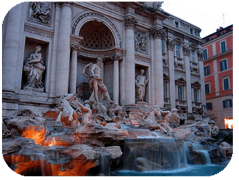 The beauty of Italy’s ancient structures and sculptures has been renowned for more than two thousand years. Over the course of those centuries, maintenance responsibilities for the nation’s antiquities have transferred from their Roman builders to the Catholic Church and finally to the present-day Italian government. But there’s one major matter that separates the latter from its two mighty predecessors: money. As a result of the Italian economy’s recent collapse, the government has been forced to slash the maintenance budget for its old-world treasures by 20 percent since 2010.
The beauty of Italy’s ancient structures and sculptures has been renowned for more than two thousand years. Over the course of those centuries, maintenance responsibilities for the nation’s antiquities have transferred from their Roman builders to the Catholic Church and finally to the present-day Italian government. But there’s one major matter that separates the latter from its two mighty predecessors: money. As a result of the Italian economy’s recent collapse, the government has been forced to slash the maintenance budget for its old-world treasures by 20 percent since 2010.
With the government unable to protect its ancient assets, responsibility has fallen at the feet of the nation’s modern cultural institutions. For instance, when a piece fell off of Rome’s famed Trevi Fountain last summer, the government appealed for outside help. Aid arrived swiftly from Fendi, the upscale fashion brand spearheaded by Karl Lagerfeld. The company plans to spend nearly $3 million over the next two years to completely overhaul the 17th century fountain. Fendi is far from the only high roller providing financial relief for Italy’s crumbling masterpieces. The apparel company Diesel is bankrolling a $6.7 million restoration of Venice’s Rialto Bridge while shoemaker Tod’s Group has pledged €25 million towards repairing the Roman Coliseum.
For these luxury brands, maintaining Italy’s glamorous reputation is essential for their success. Some even have intimate ties with the monuments they’ve chosen to restore, such as Fendi, whose founding location sits less than a ten-minute walk away from the Trevi Fountain. Nevertheless, most of Italy’s haute brands are receiving small returns for their investments. Tod’s Group will be able to place its logo on all tickets sold to the Coliseum. While Fendi won’t receive such a direct reward, the company will be recognized with a plaque that will remain by the fountain for three years. This modern system of patronage may not be the most efficient way to preserve Italy’s heritage, however. Archaeologists fear that thousands of less prestigious ancient attractions could fall into deeper disrepair as the nation’s patrons focus on high profile projects.
Questions:
- How do companies benefit by providing corporate support for cultural landmarks?
- Why did the Italian government refuse such support of landmarks in the past?
Source: Stephan Faris, “Italy’s Luxury Companies Step Up to Restore Monuments,” Bloomberg BusinessWeek, January 31, 2013. Photo by Chris Wee.
